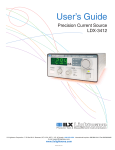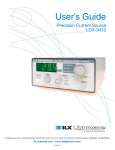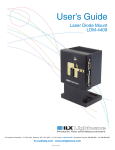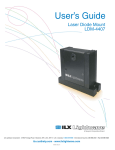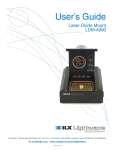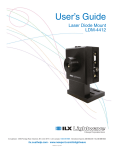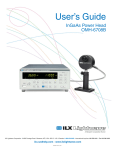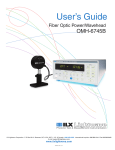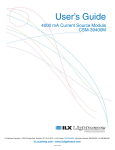Download LightWave Systems Video Game Controller Laser Diode Temperature Controller User's Manual
Transcript
User’s Guide Laser Diode Temperature Controller LDX-5100 ILX Lightwave Corporation · P. O. Box 6310 · Bozeman, MT, U.S.A. 59771 · U.S. & Canada: 1-800-459-9459 · International Inquiries: 406-556-2481 · Fax 406-586-9405 ilx.custhelp.com · www.ilxlightwave.com 70014302 May 2007 TA B L E O F C O N T E N T S TABLE OF CONTENTS Table of Contents . . . . . . . . . . . . . . . . . . . . . . . . . . . . . . . . . . . . . . . . . . . i Safety and Warranty Information . . . . . . . . . . . . . . . . . . . . . . . . . . . . . . iii Safety Information and the Manual . . . . . . . . . . . . . . . . . . . . . . . . . . . . . . . . . iii General Safety Considerations . . . . . . . . . . . . . . . . . . . . . . . . . . . . . . . . . . . . iii Safety Symbols . . . . . . . . . . . . . . . . . . . . . . . . . . . . . . . . . . . . . . . . . . . . . . . . . . iv Safety Marking Symbols . . . . . . . . . . . . . . . . . . . . . . . . . . . . . . . . . . . . . . . . . iv Warranty . . . . . . . . . . . . . . . . . . . . . . . . . . . . . . . . . . . . . . . . . . . . . . . . . . . . . . . . v Limitations . . . . . . . . . . . . . . . . . . . . . . . . . . . . . . . . . . . . . . . . . . . . . . . . . . v Returning an Instrument . . . . . . . . . . . . . . . . . . . . . . . . . . . . . . . . . . . . . . . v Claims for Shipping Damage . . . . . . . . . . . . . . . . . . . . . . . . . . . . . . . . . . . . vi Comments, Suggestions, and Problems . . . . . . . . . . . . . . . . . . . . . . . . . . . .vii Chapter 1 Introduction Product Overview . . . . . . . . . . . . . . . . . . . . . . . . . . . . . . . . . . . . . . . . . . . . . . . . 2 Thermoelectric Temperature Control . . . . . . . . . . . . . . . . . . . . . . . . . . . . . . . 2 Specifications1 . . . . . . . . . . . . . . . . . . . . . . . . . . . . . . . . . . . . . . . . . . . . . . . . . . . 3 Chapter 2 Operation Thermistor Resistance Set Point . . . . . . . . . . . . . . . . . . . . . . . . . . . . . . . . . . . . 5 Internal . . . . . . . . . . . . . . . . . . . . . . . . . . . . . . . . . . . . . . . . . . . . . . . . . . . . . . 5 External . . . . . . . . . . . . . . . . . . . . . . . . . . . . . . . . . . . . . . . . . . . . . . . . . . . . . . 5 Thermistor Current Source . . . . . . . . . . . . . . . . . . . . . . . . . . . . . . . . . . . . . . . . 6 Current Limit (J4) . . . . . . . . . . . . . . . . . . . . . . . . . . . . . . . . . . . . . . . . . . . . . . . . 6 05_07 LDT-5100 i TA B L E O F C O N T E N T S TEC Gain . . . . . . . . . . . . . . . . . . . . . . . . . . . . . . . . . . . . . . . . . . . . . . . . . . . . . . . 6 Measurement/Control (J2) . . . . . . . . . . . . . . . . . . . . . . . . . . . . . . . . . . . . . . . . . 6 Output Off . . . . . . . . . . . . . . . . . . . . . . . . . . . . . . . . . . . . . . . . . . . . . . . . . . . . 6 Output Monitors . . . . . . . . . . . . . . . . . . . . . . . . . . . . . . . . . . . . . . . . . . . . . . . 7 Thermistor Monitor . . . . . . . . . . . . . . . . . . . . . . . . . . . . . . . . . . . . . . . . . . . . 7 TE Drive Current Monitor . . . . . . . . . . . . . . . . . . . . . . . . . . . . . . . . . . . . . . . 7 Status Monitors . . . . . . . . . . . . . . . . . . . . . . . . . . . . . . . . . . . . . . . . . . . . . . . . Thermistor Open (pin 6) . . . . . . . . . . . . . . . . . . . . . . . . . . . . . . . . . . . . . . . . TEC Open (pin 4) . . . . . . . . . . . . . . . . . . . . . . . . . . . . . . . . . . . . . . . . . . . . . Output On/Off (pin 2) . . . . . . . . . . . . . . . . . . . . . . . . . . . . . . . . . . . . . . . . . . 7 7 7 8 LED Indicators . . . . . . . . . . . . . . . . . . . . . . . . . . . . . . . . . . . . . . . . . . . . . . . . . . . 8 TEC I/O Connector (J1) . . . . . . . . . . . . . . . . . . . . . . . . . . . . . . . . . . . . . . . . . . . . 8 DC Power-In Connector (J3) . . . . . . . . . . . . . . . . . . . . . . . . . . . . . . . . . . . . . . . . 8 Chapter 3 Calibration Thermistor Current Source Calibration . . . . . . . . . . . . . . . . . . . . . . . . . . . . . . . 9 TE Current Limit Calibration . . . . . . . . . . . . . . . . . . . . . . . . . . . . . . . . . . . . . . . 9 ii LDT-5100 SAFETY AND WARRANTY INFORMATION The Safety and Warranty Information section provides details about cautionary symbols used in the manual, safety markings used on the instrument, and information about the Warranty including Customer Service contact information. Safety Information and the Manual Throughout this manual, you will see the words Caution and Warning indicating potentially dangerous or hazardous situations which, if not avoided, could result in death, serious or minor injury, or damage to the product. Specifically: Caution indicates a potentially hazardous situation which can result in minor or moderate injury or damage to the product or equipment. Warning indicates a potentially dangerous situation which can result in serious injury or death. General Safety Considerations If any of the following conditions exist, or are even suspected, do not use the instrument until safe operation can be verified by trained service personnel: • Visible damage • Severe transport stress • Prolonged storage under adverse conditions • Failure to perform intended measurements or functions If necessary, return the instrument to ILX Lightwave, or authorized local ILX Lightwave distributor, for service or repair to ensure that safety features are maintained (see the contact information on page vii). All instruments returned to ILX Lightwave are required to have a Return Authorization Number assigned by an official representative of ILX Lightwave Corporation. See Returning an Instrument on page v for more information. Safety and Warranty Information iii S A F E T Y A N D WA R R A N T Y I N F O R M A T I O N Safety Symbols S AFETY S YMBOLS This section describes the safety symbols and classifications. Technical specifications including electrical ratings and weight are included within the manual. See the Table of Contents to locate the specifications and other product information. The following classifications are standard across all ILX Lightwave products: • Indoor use only • Ordinary Protection: This product is NOT protected against the harmful ingress of moisture. • Class I Equipment (grounded type) • Electrical Rating: 100 - 240 V; ~ 2.5A; 225W; 50/60 Hz • Mains supply voltage fluctuations are not to exceed ±10% of the nominal supply voltage. • Pollution Degree 2 • Installation (overvoltage) Category II for transient overvoltages • Maximum Relative Humidity: <80% RH, non-condensing • Operating temperature range of 10 °C to 40 °C • Storage and transportation temperature of –40 °C to 70 °C • Maximum altitude: 3000 m (9843 ft) • This equipment is suitable for continuous operation. Safety Marking Symbols This section provides a description of the safety marking symbols that appear on the instrument. These symbols provide information about potentially dangerous situations which can result in death, injury, or damage to the instrument and other components. Caution, refer to manual Earth ground Terminal Alternating current Visible and/or invisible laser radiation Caution, risk of electric shock Protective Conductor Terminal Caution, hot surface Frame or chassis Terminal On: In position of a bistable push control. The slash (I) only denotes that mains are on. or (I) iv Safety and Warranty Information Off: Out position of a bistable push control. The circle (O) only denotes that mains are off. or (O) S A F E T Y A N D WA R R A N T Y I N F O R M A T I O N Warranty WARRANTY ILX LIGHTWAVE CORPORATION warrants this instrument to be free from defects in material and workmanship for a period of one year from date of shipment. During the warranty period, ILX will repair or replace the unit, at our option, without charge. Limitations This warranty does not apply to fuses, lamps, defects caused by abuse, modifications, or to use of the product for which it was not intended. This warranty is in lieu of all other warranties, expressed or implied, including any implied warranty of merchantability or fitness for any particular purpose. ILX Lightwave Corporation shall not be liable for any incidental, special, or consequential damages. If a problem occurs, please contact ILX Lightwave Corporation with the instrument's serial number, and thoroughly describe the nature of the problem. Returning an Instrument If an instrument is to be shipped to ILX Lightwave for repair or service, be sure to: 1 Obtain a Return Authorization number (RA) from ILX Customer Service. 2 Attach a tag to the instrument identifying the owner and indicating the required service or repair. Include the instrument serial number from the rear panel of the instrument. 3 Attach the anti-static protective caps that were shipped with the instrument and place the instrument in a protective anti-static bag. 4 Place the instrument in the original packing container with at least 3 inches (7.5 cm) of compressible packaging material. Shipping damage is not covered by this warranty. 5 Secure the packing box with fiber reinforced strapping tape or metal bands. 6 Send the instrument, transportation pre-paid, to ILX Lightwave. Clearly write the return authorization number on the outside of the box and on the shipping paperwork. ILX Lightwave recommends you insure the shipment. If the original shipping container is not available, place your instrument in a container with at least 3 inches (7.5 cm) of compressible packaging material on all sides. Repairs are made and the instrument returned transportation pre-paid. Repairs are warranted for the remainder of the original warranty or for 90 days, whichever is greater. Version 1 Safety and Warranty Information v S A F E T Y A N D WA R R A N T Y I N F O R M A T I O N Warranty Claims for Shipping Damage When you receive the instrument, inspect it immediately for any damage or shortages on the packing list. If the instrument is damaged, file a claim with the carrier. The factory will supply you with a quotation for estimated costs of repair. You must negotiate and settle with the carrier for the amount of damage. vi Safety and Warranty Information S A F E T Y A N D WA R R A N T Y I N F O R M A T I O N Warranty Comments, Suggestions, and Problems To ensure that you get the most out of your ILX Lightwave product, we ask that you direct any product operation or service related questions or comments to ILX Lightwave Customer Support. You may contact us in whatever way is most convenient: Phone . . . . . . . . . . . . . . . . . . . . . . . . . . . (800) 459-9459 or (406) 586-1244 Fax . . . . . . . . . . . . . . . . . . . . . . . . . . . . . . . . . . . . . . . . . . . . . (406) 586-9405 On the web at: . . . . . . . . . . . . . . . . . . . . . . . . . . . . . . . www.ilxlightwave.com Or mail to: ILX Lightwave Corporation P. O. Box 6310 Bozeman, Montana, U.S.A 59771 www.ilxlightwave.com When you contact us, please have the following information: Model Number: Serial Number: End-user Name: Company: Phone: Fax: Description of what is connected to the ILX Lightwave instrument: Description of the problem: If ILX Lightwave determines that a return to the factory is necessary, you are issued a Return Authorization (RA) number. Please mark this number on the outside of the shipping box. You or your shipping service are responsible for any shipping damage when returning the instrument to ILX Lightwave; ILX recommends you insure the shipment. If the original shipping container is not available, place your instrument Version 1 Safety and Warranty Information vii S A F E T Y A N D WA R R A N T Y I N F O R M A T I O N Warranty in a container with at least 3 inches (7.5 cm) of compressible packaging material on all sides. viii Safety and Warranty Information CHAPTER 1 INTRODUCTION This manual contains operation, calibration and specification information for the LDT-5100. It is recommended that the user become thoroughly familiar with this information prior to operating the LDT-5100. If any of the following symptoms exist, or are even suspected, remove the LDT-5100 Temperature Controller from service. Do not use until trained service personnel can verify safe operation. Visible damage Severe transport stress Prolonged storage under adverse conditions Failure to perform intended measurements or functions If necessary, return the LDT-5100 Laser Diode Current Source to ILX Lightwave for service and repair to ensure that safety features are maintained. Follow the “Returning an Instruments” process described on page xi. LDT-5100 1 CHAPTER 1 INTRODUCTION Product Overview Product Overview The LDT-5100 Temperature Controller is a device which, when powered by the appropriate supply, measures the temperature dependent resistance of a thermistor. Using this resistance as feedback, it stabilizes temperature by driving current to a thermoelectric (TE) module. The TE drive for the LDT-5100 is bipolar (positive current to cool; negative current to heat). This allows for highly stable temperatures and fast settling times. Desired temperature (thermistor resistance) is set by adjusting an on-board trimpot or by connecting an external reference resistor (for a more precise setpoint). Thermoelectric Temperature Control More information about controlling temperature with thermoelectric modules is available in ILX Lightwave Application Notes, which are available at www.ilxlightwave.com. External power supplies are required to power the LDT-5100’s control and monitoring circuits. Please refer to the specifications on page 3 for power supply requirements. Voltage outputs are provided for thermistor resistance and TE module current monitoring. Status monitors for open thermistor, TEC open, and output on/off are provided as an open collector outputs for logic compatibility with other instructions. Pads for LEDs are located on the LDT-5100 PCB that correspond to the three status monitors. 2 LDT-5100 INTRODUCTION Specifications1 CHAPTER 1 Specifications 1 INPUTS Power Supply + 12 to 18 Volts at 75 mA2 + 4.5 to 7 Volts at 2 A3 Control Output On (Default) when power supplied; user can control output on / off with TTL line (Low = output off) Thermistor R Setting4 Jumper selectable internal/external Rset Thermistor R driven to match reference precision resistor across connector pins 5, 6 50 kΩ adjustable 10 T pot External Rset Internal Rset Thermistor Current Jumper selectable 10 µA / 100 µA ITE Limit Jumper selectable: 250 mA, 500 mA, 1A, 1.5A, 2A Limit Accuracy + 50 mA TEC Gain 1 to 50; adjustable 1-turn pot OUTPUTS Output Type Bipolar, floating, constant current source Current Range -2A to 2A Compliance Voltage > 2 VDC Stability (24 hours)5 Internal Rset + 0.01 oC External Rset +0.005 oC Temperature Coefficient Internal Rset 0.01 oC / oC (ambient) External Rset 0.005 oC / oC (ambient) Thermistor Measurement Buffered output voltage: -5V to +5V Transfer Function 100 µA range 10 kΩ / V 10 µA range 100 kΩ / V Accuracy 100 µA range +50 Ω 10 µA range +500 Ω ITE Measurement 05_07 Buffered output voltage: -5V to +5V Transfer Function 400 mA / V Accuracy + 40 mA LDT-5100 3 CHAPTER 1 INTRODUCTION Specifications1 LED Indicators 4 LDT-5100 Output On PCB pads for external LED (10 mA) and open collector output6 TEC Open Error PCB pads for external LED (10 mA) and open collector output6 Sensor Open Error PCB pads for external LED (10 mA) and open collector output6 GENERAL LDT-5100 Size 1.75” x 3.75” x 5.5” (44mm x 95mm x 139mm) Weight 8.75 oz Operating Temperature 0 to 50 oC Storage Temperature -40 to 70 oC 1. 2. 3. 4. All values tested after a one hour warm up period. Additional current is needed if external LED indicators are used (approximately 10 mA per LED) Higher voltage allowed with use of additional heat-sinking of mounting plate. Use of an external precision resistor is the recommended method to set desired thermistor R. 5. 6. Over any 24 hour period, controlling an LDM-4412 mount at 25 oC with a 10 kΩ thermistor on 100 µA setting. Open collector outputs for TEC open error, sensor open error and output on indicator can be used to control other functions such as laser output disable line on the LDX-3100 current source. CHAPTER 2 OPERATION See Figure 2.1 for location and identification of control connectors and jumpers. Thermistor Resistance Set Point Two methods of thermistor R set point control are provided in the LDT-5100; internal resistor or external resistor. A jumper, “RESISTOR SEL”, (J6) is used to select which resistor is used as the set point reference for the control loop. (A jumper on the left and center pins selects external resistor. Right and center pins select internal resistor). Note: A jumper must be present in one of the positions for the control loop to function. Internal In this mode, a 50 kΩ on board trim pot, “R SET” (R52) is used to set the control resistance. Adjustment of this pot will cause the control loop to adjust the load temperature so that the sensor thermistor value equals the trim pot resistance. Although this will work in either thermistor current setting, improved accuracy will result if the 100 µA range is used. External In this mode, the loop will use the resistance between pins 5 and 6 of the “TEC I/O” connector (J1) as the set point. A fixed resistor should be used to achieve the best load temperature stability. A variable resistor can also be used if fine adjustment is required. The resistor value used will depend on the thermistor sensor chosen and the current source range selected. LDT-5100 5 CHAPTER 2 OPERATION Figure 2.1 LDT-5100 Control/Monitor Connections 6 LDT-5100 OPERATION Thermistor Current Source CHAPTER 2 Thermistor Current Source For a greater range of temperature sensing, two current sources are provided on the LDT-5100; 100 µA and 10 µA. Each source is selectable on the “THERMISTOR CURRENT” jumper (J5). The default setting from the factory is 100µA. Note: If the jumper is removed, the 100 µA current source (default) is selected. The choice of current source will depend on the thermistor sensor used. Please refer to LX Lightwave Application Note #2, Selecting and Using Thermistors for Temperature Control. Current Limit (J4) The current limit selector (J4) allows the user to set the upper limit of the TE drive current. The TE current limit is jumper selectable to five (5) values, 250mA, 500mA, 1A, 1.5A and 2A. The default limit is set to the minimum limit current of 250mA. The limit is for both positive and negative load currents. The limit current value is selected by placement of a jumper at the indicated position on the “CURRENT LIMIT” connector (J4). A jumper must be used in one of the five positions in order for the LDT-5100 to function. TEC Gain The proportional term of the LDT-5100 control loop can be adjusted with the “TEC GAIN” trim pot (R44). When adjusted fully clockwise, the TEC GAIN is in the MAX position. This corresponds to a proportional term gain of 50. With the TEC GAIN adjusted fully counter-clockwise, the proportional term gain will be 1. Measurement/Control (J2) Output Off An output off control line is provided at pin 1 of the measurement / control connector (J2). When no connection is made, this line is internally pulled high and the output is turned on (current is provided to the TE output). This is also the condition at power-up. If the control line is grounded, the output will be off (no current provided to the TE output). The control line input is a MOSFET allowing a large variation in “low” voltage levels. 05_07 LDT-5100 7 CHAPTER 2 OPERATION Measurement/Control (J2) Output Monitors The LDT-5100 has two buffered output monitors present on the measurement / control connector (J2). These monitor the actual thermistor resistance and ITE (TE drive current). Thermistor Monitor The thermistor monitor (pin 10) provides an output voltage which is proportional to the thermistor sense resistor value. The transfer function with the 100µA thermistor current range selected is 10kΩ/V and with the 10µA thermistor current range selected,100kΩ/V. The accuracy is specified to 5V although higher output voltages can be measured. TE Drive Current Monitor A TE drive current monitor, ITE, is also provided as a buffered output on pin 8 of the measurement / control connector (J2). This voltage output is proportional to ITE with a 400mA/V transfer function. Note: This is a bipolar output. Status Monitors The LDT-5100 measurement / control connector (J2) includes three status lines which provide information about the instrument operation. They are thermistor open, TEC open and output on. All outputs are open collector, allowing for a wide variety of logic compatibility, including wired “or” operation. A pull-up resistor from the user’s power supply is required. This power supply must also be connected to the LDT-5100 ground reference for proper operation. Sink current in excess of 25 mA should be avoided when choosing the value of the pull-up resistor. Thermistor Open (pin 6) This control line is grounded (low) when the thermistor input, pins 7 and 8 of J1, have a high impedance. The threshold for determination of high impedance is dependent on the thermistor current range selected. The thresholds are 90 kΩ and 900 kΩ for the 100 µA and 10 µA thermistor current ranges respectively. When the sensor resistance is within the ranges indicated, the control line will be high impedance, indicating an open thermistor. TEC Open (pin 4) This control line is grounded (low) when the TE module (+) and (-) inputs have a high impedance. If the LDT-5100 tries to drive current to the TE, but is unable to do so, an open TEC is assumed. Because of variation in TE load impedance and 8 LDT-5100 OPERATION LED Indicators CHAPTER 2 supply voltage, this threshold is not a fixed value. Under normal operation (with a low impedance TE), the control line will be in a high impedance state. Output On/Off (pin 2) This control line indicates if the TE output is on (driving current to a TE load). A ground at this control line indicates that the output is off and no current is being driven through the TE modules. LED Indicators Pads are located on the LDT-5100 PCB to allow direct connection of indicator LEDs. The indicator LEDs correspond to the three status lines described above. These pads are internally referenced and do not require an external supply connection. The ANODE pin of all three LEDs are connected so that a single common wire can be used for remote LED indicators. The error LED indicators (TEC Open (D3) and Thermistor Open (D1) are illuminated when an error is sensed. The OUTPUT ON indicator (D4) is illuminated when the output is on. Note: If LEDs are used, the current requirement for the -15V supply should be increased accordingly. TEC I/O Connector (J1) The 15-pin D-sub I/O connector pinout is shown in Figure 2.1. Simply connect your TE module to the proper pins (observing the polarity of the TE) and connect the thermistor sensor to complete the loop. The function of the external reference resistor (pins 5 and 6) is described above under “Thermistor Resistance Set Point”. A control signal at pin 10 provides a 1 V/A signal which can be used to drive booster current supplies. DC Power-In Connector (J3) Separate ground leads are provided for the high current TE supply return and control circuit ground reference. These pins (2 and 4) are connected on the LDT-5100 PCB. To eliminate ground fluctuations caused by large TE current draw, the TE return should be connected to the control supply only at the LDT-5100 PCB. 05_07 LDT-5100 9 CHAPTER 10 LDT-5100 2 OPERATION DC Power-In Connector (J3) CHAPTER 3 CALIBRATION Thermistor Current Source Calibration To calibrate the thermistor current source, connect an ammeter in series with a 10 kΩ resistor at the output connector (J1). 1 Place the thermistor current jumper (J5) in the 100 µA position. 2 Adjust trim pot R51 to read 100.00 µA on the current meter. 3 Place the thermistor current jumper (J5) in the 10 µA position. 4 Adjust trim pot R50 to read 10.00 µA on the current meter. TE Current Limit Calibration To calibrate the ITE limit current, connect a fixed known load (approximately 1.0 Ω / 25 Watt) at the TE output. 1 Set the current limit jumper to the 1 Amp position. 2 Set the resistor select jumper in the internal position. 3 Adjust trim pot R52 so that a negative ITE current is produced. 4 Measure the voltage developed across the load with a voltmeter. 5 Adjust trim pot R5 so that the output current is 1.00 Amps. LDT-5100 9 CHAPTER 10 LDT-5100 3 CALIBRATION TE Current Limit Calibration






















